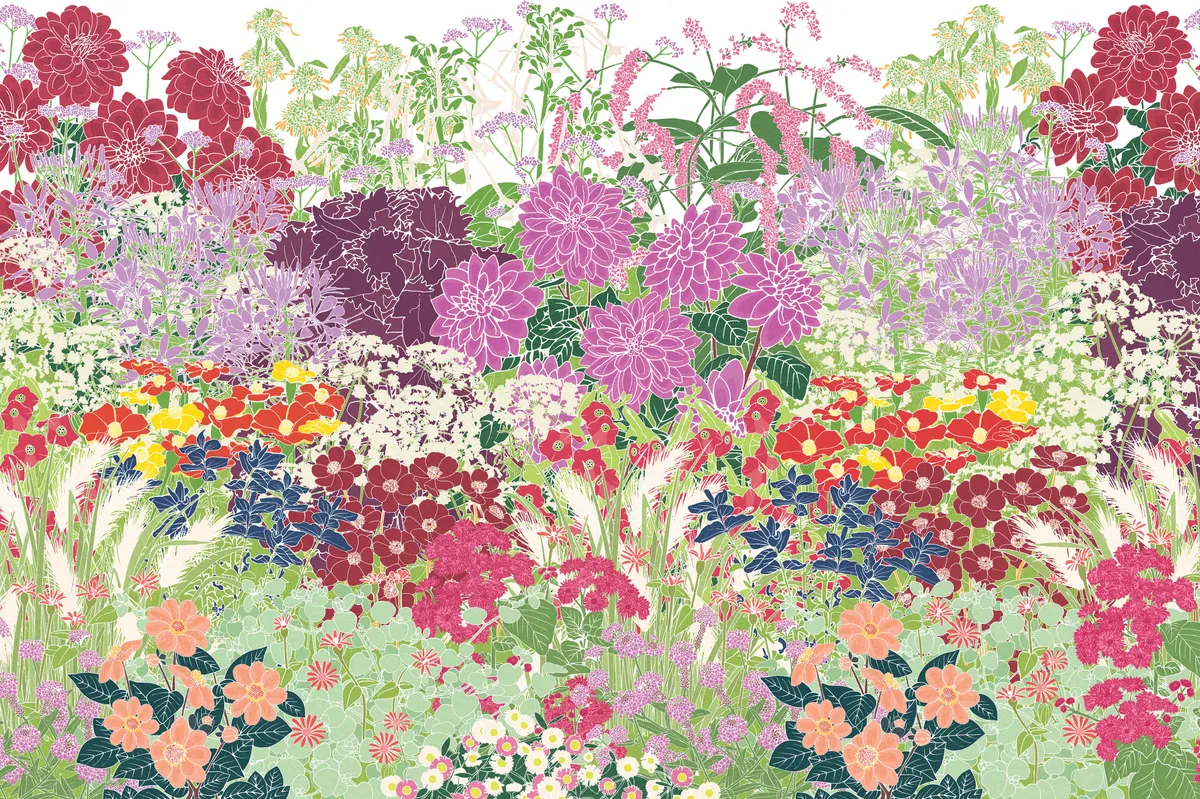Using mainly annuals, Dutch nursery owners and planting designers Helen Lewis and Wilko Karmelk create a stunning chic and cheerful border
We have designed a 5m x 3m border for a sunny position, combining annuals and summer-flowering tubers. Some of the plants selected would perform equally well in semi-shade, such as Erigeron karvinskianus, Nicotiana sylvestris and Nicotiana ‘Tinkerbell’.
We always begin our planting designs by writing up a plant list, considering leaf form, flower shape and colour, dividing this into three sub-lists of plants for the back, middle and front of a border. To add rhythm and to make it easy on the eye we always consider repeating certain plants. We also select a few plants to weave through when everything has been planted. These link all the other chosen plants together. For this design they are Ammi majus, Verbena bonariensis and Zinnia ‘Red Spider’.

Where to start
For the back of the border, we chose Dahlia ‘Karma Naomi’, Nicotiana sylvestris, Leonotis‘Navajo Apricot’ and Persicaria orientalis. The central section features Ammi majus, Cleome hassleriana ‘Violet Queen’, Dahlia ‘Le Baron’, Nicotiana ‘Tinkerbell’, Perilla frutescens var. crispa (formerly nankinensis) and Tagetes ‘Linnaeus’. In the front are Ageratum ‘Red Sea’, Cosmos atrosanguineus, Dahlia ‘Scura’, Erigeron karvinskianus, Helichrysum petiolare, Pennisetum villosum, Salvia ‘Blue Denim’ and Verbena rigida.
Growing plants from seed keeps costs to a minimum, and all but two of the plants in our list may be grown in this way. The exceptions are Helichrysum petiolare, which is easier bought in as plugs, and the dahlias, which don’t come true from seed so it’s best to use tubers. Check the information on seed packets for the best time to sow, whether they germinate better in the light or dark, can be sown inside under glass or protection (from mid-March until the end of April), or outside in a prepared seed bed. Some plants, such as poppies, are best sown directly in open ground because their root system makes them hard to transplant.
From mid-May all the plants can be planted outside. The general planting distance is about 20cm for the lower front plants and 30cm for the middle and higher plants at the back of the border. Further maintenance from June will include supporting Dahlia ‘Le Baron’ and from July you’ll need to deadhead your dahlias to keep the border looking good for as long as possible.
As for any border, fertilising is crucial for optimal results. Annuals and dahlias are heavy feeders; if you are using organic fertiliser it is best to apply this in March/April and a second feed in July. If you’re using artificial fertiliser your plants require a feed once every six weeks. By doing this your annual border will flower non stop until autumn, when it’s time to go in the garden with empty envelopes and a pen and harvest your seeds to begin all over again the following year.
Helen Lewis and Wilko Karmelk own Ferdinandushof, a perennials nursery between the Belgian cities of Ghent and Antwerp. Tel +31 (0)115 482041, www.ferdinandushof.nl (Dutch only).
Click the link below to download a PDF of the border plan